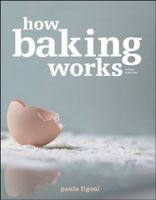5. Egg and Gluten Proteins Coagulate.
By Paula Figoni
Published 2003
While the changes that occur in eggs as they are heated are visible, the protein molecules that cause these changes are not—not even under a microscope. If they were visible, raw egg proteins would appear as relatively large coiled molecules surrounded by water. As they are heated, the molecules unfold (denature) and bond with one another to form clusters (Figure 3.2). These clusters of coagulated egg protein trap water and form a continuous network that surrounds air cells. At the same time, cell walls stretch from the pressure of expanding gases. Eventually, water escapes from the proteins, the bonding proteins become rigid, the cell walls lose their ability to stretch, and the pressure from expanding gases ruptures the rigid cell walls, so they become porous. It is this rigid structure that helps set the final size and shape of baked goods. The process of egg protein coagulation is discussed in more detail in Chapter 10. The changes to gluten proteins are discussed in Chapter 7.
Part of
Advertisement
Advertisement


